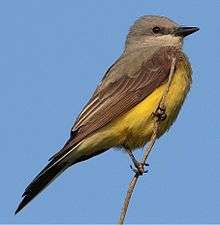Western kingbird
| Western kingbird | |
|---|---|
 | |
| Scientific classification | |
| Kingdom: | Animalia |
| Phylum: | Chordata |
| Class: | Aves |
| Order: | Passeriformes |
| Family: | Tyrannidae |
| Genus: | Tyrannus |
| Species: | T. verticalis |
| Binomial name | |
| Tyrannus verticalis Say, 1823 | |
The western kingbird (Tyrannus verticalis) is a large tyrant flycatcher.
Adults are grey-olive on the upperparts with a grey head and a dark line through the eyes; the underparts are light becoming light orange-yellow on the lower breast and belly. They have a long black tail with white outer feathers. Western kingbirds also have a reddish crown that they only display during courtship and confrontations with other species.

| Standard Measurements[2][3] | |
|---|---|
| length | 8–9.3 in (200–240 mm) |
| weight | 40 g (1.4 oz) |
| wingspan | 15.5 in (390 mm) |
| wing | 125.5–133.5 mm (4.94–5.26 in) |
| tail | 88.5–96.5 mm (3.48–3.80 in) |
| culmen | 20.5–22.5 mm (0.81–0.89 in) |
| tarsus | 18.5–19.5 mm (0.73–0.77 in) |
The Western Kingbird is very similar to and easily confused with Cassin's kingbird, Couch's kingbird and the tropical kingbird, all of which overlap the western kingbird's range to some extent. The western, however, is generally lighter in coloration and can be distinguished from these species by the black squared tail with white outer webs, as well as voice.[3]
Their breeding habitat is open areas in western North America. The increase in trees throughout the Great Plains during the past century due to fire suppression and tree planting facilitated the range expansion of the western kingbird[4][5] as well as range expansions of many other species of birds.[6][7][8] Kingbirds make a sturdy cup nest in a tree or shrub, sometimes on top of a pole or other man-made structure. Three to five eggs are laid and incubated for 12 to 14 days.[2]
The name kingbird is derived from their "take-charge" behaviour. These birds aggressively defend their territory, even against much larger birds such as hawks.
These birds migrate in flocks to Florida and the Pacific coast of southern Mexico and Central America.
They wait on an open perch and fly out to catch insects in flight, sometimes hovering and then dropping to catch food on the ground. They also eat berries.
The song is a squeaky chatter, sometimes compared to a squeaky toy. The call is a sharp loud whit. It occasionally sings before sunrise.
References
- ↑ BirdLife International (2012). "Tyrannus verticalis". IUCN Red List of Threatened Species. Version 2013.2. International Union for Conservation of Nature. Retrieved 26 November 2013.
- 1 2 Godfrey, W. Earl (1966). The Birds of Canada. Ottawa: National Museum of Canada. pp. 249–250.
- 1 2 Sibley, David Allen (2000). The Sibley Guide to Birds. New York: Knopf. pp. 336–337. ISBN 0-679-45122-6.
- ↑ Houston S. 1979. The spread of the Western Kingbird across the prairies. Blue Jay 37:149–157.
- ↑ Gamble LR, Bergin TM. 1996. Western Kingbird (Tyrannus verticalis), no. 227. In: A. Poole (ed.). The Birds of North America Online. Cornell Lab of Ornithology, Ithaca, New York
- ↑ Livezey KB. 2009a. Range expansion of Barred Owls, part I: chronology and distribution. American Midland Naturalist 161:49–56.
- ↑ Livezey KB. 2009b. Range expansion of Barred Owls, part 2: facilitating ecological changes. American Midland Naturalist 161:323–349.
- ↑ Livezey KB. 2010. Killing barred owls to help spotted owls II: implications for many other range-expanding species. Northwestern Naturalist 91:251–270.
External links
| Wikimedia Commons has media related to Tyrannus verticalis. |
| Wikispecies has information related to: Tyrannus verticalis |
- Western kingbird Species account - Cornell Lab of Ornithology
- Western kingbird - Tyrannus verticalis - USGS Patuxent Bird Identification InfoCenter
- Western kingbird attacking red tailed hawk with photo - Denver Post, 30 September 2009
- BirdLife species factsheet for Tyrannus verticalis
- "Tyrannus verticalis". Avibase.

- "Western kingbird media". Internet Bird Collection.
- Western kingbird photo gallery at VIREO (Drexel University)
- Interactive range map of Tyrannus verticalis at IUCN Red List maps
- Audio recordings of Western kingbird on Xeno-canto.
